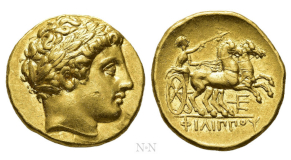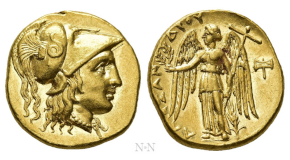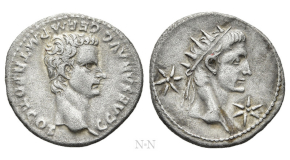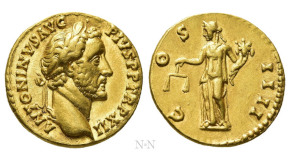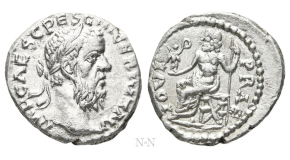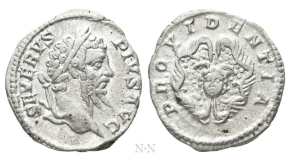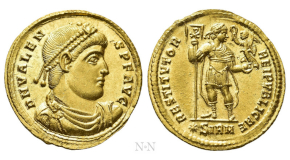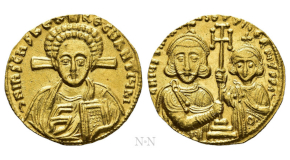
Auktion Nr. 159
Antike und Moderne Münzen (Lose 1-1342)
Das Live bidding startet am 07. Dezember 2025 ab 17:00 Uhr
First Sunday of the month is Naumann Sunday!
Münzen der Kelten
★ Mint State Kreuzelreiter ★
EASTERN EUROPE. Imitations of Philip II of Macedon (2nd century BC). Tetradrachm. ‚Kreuzelreiter‘ type
Obv: Stylized head of Zeus right.
Rev: Youth riding horse right; cross above.
Lanz 408; OTA 108/2.
Condition: Mint State.
Weight: 10.77 g.
Diameter: 23 mm.
Münzen der Griechen
KINGS OF MACEDON. Philip II (359-336 BC). GOLD Stater. Pella.
Obv: Laureate head of Apollo right.
Rev: ΦΙΛΙΠΠΟΥ.
Charioteer driving biga right. Controls: Below horses, trident head right.
Le Rider 326 (D148/R249); SNG ANS 144-54.
Condition: Near extremely fine.
Weight: 8.61 g.
Diameter: 19 mm.
Münzen der Griechen
★ Lustrous Mint State ★
KINGS OF MACEDON. Alexander III ‚the Great‘ (336-323 BC). GOLD Stater. Miletos.
Obv: Head of Athena right, wearing Corinthian helmet decorated with serpent.
Rev: AΛEΞANΔPOY.
Nike standing left, holding wreath and stylis Control: Labrys in right field, grain ear below wing.
Price 2094.
Very rare.
Condition: Mint State.
Weight: 8.63 g.
Diameter: 18 mm.
Münzen der Griechen
★ Lustrous Mint State ★
KINGS OF MACEDON. Alexander III ‚the Great‘ (336-323 BC). GOLD Stater. Uncertain mint in western Asia Minor. Lifetime issue.
Obv: Head of Athena right, wearing Corinthian helmet decorated with serpent.
Rev: AΛEΞANΔPOY.
Nike standing left, holding wreath and stylis Control: to lower left, eagle standing left with closed wings.
Price 3125 (Salamis).
Condition: Mint State.
Weight: 8.65 g.
Diameter: 18 mm.
Münzen der Griechen
★ Lustrous Mint State ★
KINGS OF MACEDON. Alexander III ‚the Great‘ (336-323 BC). GOLD Stater. Uncertain mint in western Asia Minor. Lifetime issue.
Obv: Head of Athena right, wearing Corinthian helmet decorated with serpent.
Rev: AΛEΞANΔPOY.
Nike standing left, holding wreath and stylis Control: to lower left, eagle standing left with closed wings.
Price 3125 (Salamis).
Condition: Mint State.
Weight: 8.61 g.
Diameter: 19 mm.
Münzen der Römischen Kaiser
★ Uncirculated Pescennius Niger ★
PESCENNIUS NIGER (193-194). Denarius. Antioch.
Obv: IMP CAES C PESC NIGER IVT AV.
Laureate head right.
Rev: IOVI PRAE.
Jupiter seated left on throne, holding sceptre and victory.
RIC -; RSC -; Nomos 35, lot 708 (same dies).
Condition: Uncirculated.
Weight: 3.37 g.
Diameter: 18 mm.
Münzen der Römischen Kaiser
★ Exceptional Solidus ★
CONSTANTIUS II (337-361). GOLD Solidus. Sirmium.
Obv: FL IVL CONSTANTIVS PERP AVG.
Diademed, helmeted and cuirassed bust facing slightly right, holding spear over shoulder and shield decorated with horseman motief.
Rev: GLORIA REI PVBLICAE / SIRM (star).
Roma seated facing and Constantinopolis seated slightly left, with foot on prow, each holding scepter and supporting shield between them inscribed VOT/XXXV/MVLT/XXXX in four lines.
RIC 57; Depeyrot 10/1.
Condition: Mint State.
Weight: 4.43 g.
Diameter: 22 mm.
Münzen der Römischen Kaiser
★ Rare Solidus ★
VALENS (364-378). GOLD Solidus. Sirmium.
Obv: D N VALENS P F AVG.
Pearl-diademed, draped and cuirassed bust right.
Rev: RESTITVTOR REIPVBLICAE / (star) SIRM.
Emperor standing facing, head right, holding labarum with christogram and crowning Victory on globe.
RIC 1b (R3).
Very rare.
Condition: Near mint state.
Weight: 4.52 g.
Diameter: 22 mm.
Münzen des Byzantinischen Reichs
JUSTINIAN II with TIBERIUS (Second reign, 705-711). GOLD Solidus. Constantinople.
Obv: δ N IҺS CҺS RЄX RЄGNANTIЧM.
Facing bust of Christ Pantokrator, wearing pallium and colobium, raising hand in benediction and holding book of Gospels.
Rev: δ N IЧSTINIANЧS ЄT TIbЄRIЧS P P A.
Crowned and draped facing busts of Justinian and Tiberius, both wearing chlamys and holding between them a cross potent set upon two steps.
MIB 2b; DOC 2b; Sear 1414.
Condition: Near uncirculated.
Weight: 4.35 g.
Diameter: 21 mm.

Newsletter
Mit unserem Newsletter werden Sie stets über Neuigkeiten informiert. Verpassen Sie keine wichtige Nachricht mehr! Tragen Sie dafür nur die E-Mail Adresse ein, an die der Newsletter versendet werden soll. Natürlich können Sie den Newsletter jederzeit wieder abbestellen.
Nach Absenden des Formulars erhalten Sie von uns eine Email zur Bestätigung.




